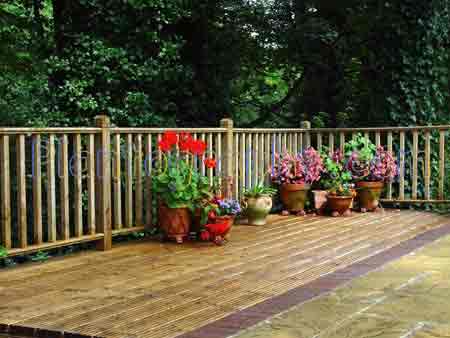Designing a deck - the plan.
A deck plan is essential for a successful decking project. The design is best put on paper rather than simply thought out and retained in your head.
Actual planning of a deck will bring things to light that may otherwise have been overlooked. Many decks are less complicated than the image below. Some are much more complex. Whatever!
They can all benefit from a deck plan - even if just to assist in calculating the timber requirements.
Before even thinking of putting a sketch on paper, the should be thought given as to what purpose the deck is going to fulfil in your garden - in your life!
After one deck installation that I carried out myself, the owner telephoned me at home on the evening of completion - I had his wife greet him to the new deck with a cooled bottle of white wine!
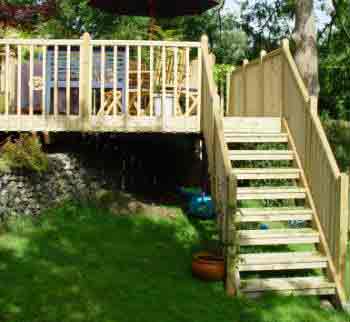 But the actual purpose of the phone call was simply to say that he
realised now, why I had been so inquisitive and asked him many questions
about the intended use of their deck.
But the actual purpose of the phone call was simply to say that he
realised now, why I had been so inquisitive and asked him many questions
about the intended use of their deck.
after a first evening on the deck - and maybe the wine helped a little - it was realised that the deck was a life-changing addition as far as garden and recreation was concerned. That is how important it is to think your design through - from concept to finished sketch/drawing. (It does NOT have to be a work of art - even a few scribbles will do!)
The actual drawing of the plan is relatively simple - for most decks are based on rectangle frame - albeit modified if you want curves, but the over riding fact is that timber comes on rectangular shapes - at least for a deck!
The Deck Design Brief!
The simple thought "We should have a deck there" opens the way for discussion on what your deck is actually going to be about.
The 'Five W's H' formula is perfect for this - as it is with any garden or other project! It never fails to find some 'obvious' answers, and usually asks some awkward questions that need to be answered!
- What? What is the deck being used for? Meals, flopping, kids, drinks BBQ, parties, business meetings, sunbathing, shade spot, covering the old patio, adding to the value of the house, making the garden more accessible, extending living space, extending house into garden, secluded space at bottom of garden, utilising the space wasted by the steep slope, getting away to a quiet spot with a book or a drink! What will the neighbours have to say or object about? The list is endless, and you will have your own questions to ask here!
- Why? Why do we actually need a deck? Would a patio be better? Why here, why not there, why timber? Why not composite.
- Where? Where is it going to go; where do we get the timber from; where is the sun going to be in the evenings - or mornings; where will we put the BBQ; where can we put plants; where will the kids fit in; where is the best place for stairs; where is the best place for access to the garden; where should we have the gap in the railings; etc etc etc.
- When? When will we use it; will it make a difference in the winter; when can I find time to build it; when can I find time to enjoy it; when will it need maintenance.
- Who? Who is going to build it WHY HOW WHEN!!!! Who will use it the most - us or the kids; who can object and why; who has a deck that we can see;
- How? How am I going to build it? (Do I really have the expertise or time) How big should it really be for now and the future; How can we pay for it; how is it going to look to the neighbours; how often can we actually use it; how can we clean it; how can we build it to make sure it is safe; how can we extend it over the bank - and so on.
Once you have answered those questions - and many more - you are ready to put thoughts to paper. Don't forget to involve everyone in the question, Have a proper discussion.
Drawing the Deck Plan.
A sheet of squared paper is by far the best way to plan out your deck. Graph paper even better because of the subdivided squares. Graph paper will allow you to accurately draw your proposal with all measurements easily worked out. Even if you are going to build a circular or curved deck, squared paper is still best. Decks are based on rectangle - full stop!
Even a standard rectangular ground level deck will benefit from the drawing of a scale plan. Much easier to calculate materials, and position the joists to avoid undue wastage when laying the deckboards.
Start with drawing the outline boundary of your deck - regardless of shape. It would also be a good idea if the deck is near to the house, to position it on the paper, showing the access points from the house and also include where the windows are! If there are any existing permanent features nearby - or trees, include these as well in the overall plan. You might then discover that a certain tree is going to block out some late sun, or perhaps by moving the site of the deck, you can use an existing garden feature as a ready-provided privacy screen. Your neighbours might appreciate this thought as well!
Sketch your plan in pencil - it is almost certain to change as you progress.
Once you have the outline settled, then you should mark out the joisting for the sub base frame. Don't skimp over this little detail - especially if the deck is to have a curved edge. You can then see how best to provide your curved edge with support. Also, how you are going to hide those supporting frame sections from view. Not a problem with a rectangular deck for a deck board fascia will normally do that for you.
Balustrade railings and stairs.
Whilst you will have thought out the details of your balustrades or railings, the position of the opening to stairs or garden might be improved upon at this stage. You will see that a central opening - especially if it forms the walkway from house to garden - will effectively reduce the usable are of your deck. The effect will be that you end up with two smaller deck spaces - cut in the middle by having to allow room for passageway! An opening at one corner will almost always be better than a central opening. At least that way, you will have one large deck area - instead of two smaller ones!
Once you have the plan drawn of the deck, if it a raised deck, then you should also do a profile drawing - sketch - showing the height of the deck at varying points - especially if it is to be constructed over a slope. The slope can be determined by following our instructions for 'levelling a garden'. here you will find an easy way to determine how much of a slope you actually have. The graph paper is also the best to use for this sketch. Doing these profiles for a sloping garden, will help you to determine how long your support posts need to be.
None of these sketches need to be works of art - simply accurate - via the graph paper - so that you can determine materials, and maybe find a few pointers on how to better position your deck. The levelling exercise is VERY IMPORTANT if you are to have a raised deck over a slope. It is so easy to underestimate the actual depth of the slope - and also the height of the deck over the steepest section of the slope. Very difficult to visualise, and the last thing you want - or will be allowed to do - is to have a deck which is higher than your surrounding fence!
1 - Building a Deck : 2 -
Versatility of Decking : 3 -
What Decking Timber : 4
- Designing the Deck - The Plan :
5 Building the Sub Deck
Frame Base : 6
Deck Frame Images :
Best Selling Gardening Products
Popular Gardening Sections

Problems
Identify Weeds in The Garden - How to deal with weeds. Diseases and Pest which harm your garden and plants, learn how to prevent, deter and erradicate your garden problems.
Garden Problems
Pruning
Pruning Guide. Shrubs flower better with correct pruning. Many illustrations and examples of what to do - and when. Includes evergreens, roses, flowering shrubs, spring flowering shrubs and pruning for stem effect. This is our most viewed and comprehensive section,
Pruning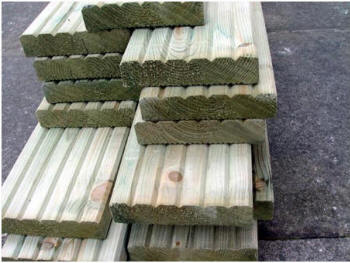
Gardening Businesses
Gardening Businesses listed in the UK counties and USA states. County and State Listings of businesses involved in Garden supplies and services. If you wish to be added to the Directory, please send us your information. Having problems, use the search box
Businesses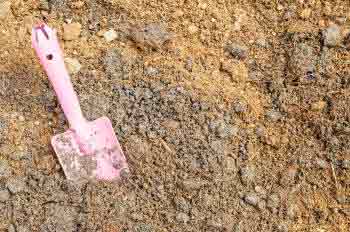
Gardening
In this section you will learn about Gardening Basics, Containers, Landscaping, Propagation and Soil.
Gardening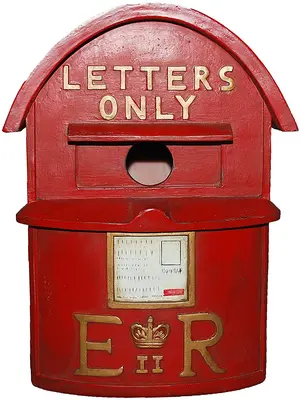
Gardening Gifts
Gardening Gifts and Reviews, Read Before you Buy
- Gardening Gifts Ideas
- Gifts For Her
- Gifts For Men
- Power Tool Gifts
- Cheap Gifts
- Personalised Gifts
- Wildlife Gifts
- Family Gifts

